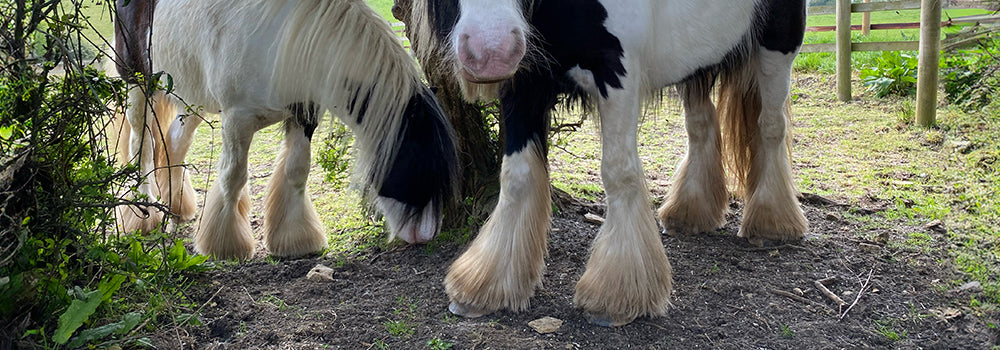
5 Ways To Manage Feathered Horse Legs with HorseWorld
|
|
Time to read 3 min
|
|
Time to read 3 min
Feathered legs can be beautiful and are an iconic feature of certain horse breeds. But, they also require regular maintenance to stay healthy, clean, and free from common problems like mites or mud fever.
At HorseWorld, we care for horses and ponies of all types, breeds, and sizes. Many are native breeds or types of cob who have very specific care requirements - especially those with particularly hairy legs! Here are our top tips for how we keep our feathered friends feeling and looking their best.
1. Routine Grooming
Regular grooming is vital for preventing problems that often hide beneath all that hair. Feathered legs can trap dirt, dead skin and scurf that mites love to feed on, so daily or frequent brushing makes a big difference.
We recommend using an EZI-GROOM premium body brush and a wide-tooth comb to gently remove tangles and debris. For tough knots, try EZI-GROOM’s mane & tail detangler spray or a grooming oil.
Tip: Always be gentle! Harsh brushing can damage the skin, making it more prone to infections.
2. Washing & Drying
Cleaning the feathers with a gentle shampoo can greatly improve hygiene and reduce the risk of skin conditions.
However, only wash the legs if needed as excessive washing can damage the skin causing other issues. A wash every couple of weeks is generally enough. Make sure to thoroughly but gently towel-dry the feathers afterwards too.
Tip: After drying, apply a light coating of mineral oil (pig oil) with sulphur to help repel mud and manage mites. Just avoid oiling in hot sun, as it can cause burns.
3. Trimming & Clipping
Feathered legs often have long, straggly hairs that grow up the legs and over the knees and hocks, front and back. You can tidy these with clippers, always moving in the same direction as the hair grows.
If clipping off the feathers is needed, avoid using the shortest setting to leave some hair coverage for skin protection and to reduce irritation from the clippers and clipper oil. Trimming helps maintain a tidy appearance while preventing matting.
Tip: Feathers do provide natural protection, so balance appearance with your horse’s health needs and always consult your vet if you are unsure.
4. Monitor For Common Problems
Feathered horses can be prone to specific conditions:
• Mud Fever (Pastern Dermatitis): Watch for scabs, redness or soreness on the lower legs. Avoid excessive wetting and keep feathers clean and dry.
• Feather Mites: Signs include stamping, biting or rubbing legs.
• Mallenders and Sallenders: Thick, scabby patches behind the knee or in the front of the hock.
• Chronic Progressive Lymphedema (CPL): Progressive swelling, skin folds and thickening that can lead to secondary infections.
Tip: Regular checks are essential, since feathers can hide early warning signs.
5. Parasite Prevention & Treatment
Feather mites are a major cause of discomfort in feathered breeds. Preventative and treatment strategies include:
• Using anti-parasitic shampoos, such as the EZI GROOM Neem shampoo and feather mite powders
• Routine application of mineral oil and sulphur
• Vet-prescribed treatments like Doramectin (Dectomax) injections or Fipronil sprays
• Permethrin washes every couple of weeks
• Keeping bedding, stables and indoor environments clean to prevent reinfestation
• Consider bedding alternatives like shavings or rubber mats instead of straw
Tip: Some off-label treatments (like Ivermectin pour on cattle dewormer) carry risks and should only be used after veterinary consultation.
Extra Tip: Don’t Forget Diet!
Healthy skin and hair start from within. A low-sugar, low-starch diet can help reduce irritation risk. Linseed (flaxseed) is a popular choice for promoting a glossy coat and healthy skin thanks to its Omega-3 content. Always tailor your horse’s diet to their needs and consult a vet or equine nutritionist for personalised advice.
Feathered legs are part of what makes certain breeds so striking, but they do need extra care. With regular maintenance, the right products and keen observation, you can keep your horse’s feathers looking beautiful and their skin healthy. If you’re ever unsure about how to manage your horse’s feathers or spot signs of a problem, consult your vet.
At HorseWorld, we’re proud to use Shires Equestrian products to help us care for our feathered horses and ponies. Why not browse the Shires online store or chat with a member of the team today to learn more about feather-care essentials?
This blog post was written by the team of experts at HorseWorld in Bristol. HorseWorld is a horse rescue charity based in the South-West. For more information, please visit our website:

